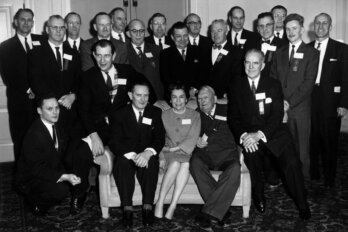Law-school graduates dream of being hired by a certain kind of employer. It’s an elite law firm full of brilliant minds. But it isn’t stuffy or conservative. Nor is it some soul-dead boiler room where the billable hour is the measure of all things. It’s a firm that attracts cutting-edge work in the sexiest and most profitable niches of the legal market and that quickly promotes talented associates into client-facing roles.
During its heyday, Heenan Blaikie arguably came as close as any Canadian law firm to realizing that ideal. Founded as a boutique operation in 1973 by three prominent Montrealers, it rose to become Canada’s sixth-largest firm. At its peak, it had almost 600 lawyers and 1,300 support staff at offices in eleven cities, including Paris and Los Angeles (the latter, a first for a Canadian law firm), and a reputation for leading work in management-side labour, entertainment, tax, oil and gas, pharmaceutical intellectual property, international mediation, and nuclear regulation. The alpha males who hung their shingle at Heenan Blaikie included Marcel Aubut (Quebec City’s answer to Donald Trump), Pierre Trudeau, Jean Chrétien, and former Quebec premier Pierre-Marc Johnson.
And yet, if you visit heenanblaikie.com today, you will find a spam website offering such articles as “How to Turn a Girl On—5 Steps to Sexual Desire.” That’s because the law firm no longer exists. In 2013—just two years after a delegation of Heenan Blaikie’s leaders toasted one another’s success at a glittering Palais de Chaillot cocktail reception marking their new Paris outpost—the firm’s two largest offices went to war. In one astonishing development, Toronto partners instructed the firm’s Montreal-based leader to stay away from the Hogtown office—surely a first in the history of Canadian law firms. In February 2014, Heenan Blaikie’s partners voted to dissolve the firm entirely. Staffers lost their jobs, and partners lost their equity. It was the largest law-firm implosion in Canadian history.
Businesses fail all the time. But what makes the Heenan Blaikie story unusual is that it does not involve any of the elements that typically spark the sudden and spectacular collapse of any big company. No large-scale scandal, no allegations of criminal conduct, no scheme to cook the books. The firm’s credit lines were still within their limits. Journalists looking for a simple narrative of the firm’s failure came away disappointed. Yes, there was an unsuccessful transatlantic gambit aimed at serving the African mining industry, a general sagging of revenues during a broader industry down-cycle, one or two newsworthy lapses by senior partners—but nothing that the firm couldn’t have survived if its management team had managed to inspire trust among rank-and-file lawyers that the business would remain a going concern. Which they didn’t.
“In a law firm the inventory walks out of the office every night,” writes long-time managing partner Norman Bacal in his newly published book, Breakdown: The Inside Story of the Rise and Fall of Heenan Blaikie. “You can only hope it returns the next morning.” In 2013 and early 2014, that inventory—otherwise known as lawyers—started leaving the building with coffee mugs and framed elementary-school art projects packed in open-top cardboard boxes. The first departures were high-level partners taking advantage of offers from competing firms. But many of those who followed left for no other reason than to beat others to the door.
It was a bank run, in other words: just as account holders at a financial institution become more likely to demand their funds when they see neighbours withdrawing their life savings, so, too, did Heenan Blaikie partners scuttle to the exits, hoping to get their partnership equity back. The stragglers were the ones who lost the most.
No one is better qualified to describe the firm’s demise than Bacal, who joined Heenan Blaikie in 1980 straight out of law school. (Or near as much: he had a short-lived prior stint selling vacuum cleaners.) Bacal made a name for himself as an up-and-coming tax lawyer in Montreal, then went on to found Heenan Blaikie’s Toronto office in 1989.
The author did not quite preside over the firm’s destruction: he stepped down as co-managing partner in 2012, a year before the implosion began. But he was in the room for almost every major decision that led to the breakup, and even launched a doomed, eleventh-hour effort to save the firm in its final months. His analysis of Heenan Blaikie’s failure is more than just long-form Bay Street gossip. Rather, it’s a fascinating cautionary tale demonstrating how businesses that flourish in start-up mode can crash if they don’t eventually adapt to the needs of a large organization operating in a mature industry.
When it was first established forty-four years ago, Johnston, Heenan, and Blaikie—as it was known then—might have seemed like a standard WASP enterprise. But by the conservative standards of the legal industry in the 1970s, its founders were visionaries. Unlike their white-shoe competitors, Roy Heenan, Peter Blaikie, and Donald Johnston created an “impeccably bilingual” firm that would span the worlds of French and English, Jewish and Gentile. The usual hang-ups about seniority and class also were dispensed with: this was a firm where a junior associate didn’t have to stare at his shoes and hold his tongue if he chanced to see a senior partner in the men’s room.
From first to last, Heenan Blaikie never had a partnership agreement. The firm was built on a handshake and a five-minute conversation at the University Club in 1973. Their bond was based on trust and collegiality, not the shared hunt for lucre.
Tax lawyers are some of the biggest nerds of the legal world. (As a former tax lawyer, I am allowed to say this.) And Bacal was a true purebred. To wit: “I wanted to be a tax lawyer. I was certain of that from the first day of second-year law school.” A wonkish introvert and family man, he seems to have internalized the Heenan Blaikie ethos from day one. Throughout the book, he calls it the Heenan Blaikie Tax: “We all might make a little less money [than similarly situated lawyers at other firms], but we were always proud of where we worked and who we were.”
Yet thanks to Bacal and his team of legal rocket scientists—Richard Lewin, Allen Garson, and Mark Jadd are among those who earn mentions—the Heenan Blaikie Tax wasn’t quite so onerous as it might have been. It was Bacal who helped invent (and then reinvent) the fantastically lucrative corporate structures that, Producers style, allowed Canadian film investors to make money even when a movie flopped. By 1988, he reports, “half the office was working on our deals.” And the millions that Bacal and his team generated for Heenan Blaikie’s coffers helped smooth some of the frictions that inevitably develop within any full-service law firm.
Unfortunately for the firm, changes to Canadian tax law killed this cash cow in 2002, and the firm struggled to develop new, equally profitable specialties. Over time, Heenan Blaikie became more like any other large firm—complete with expensive digs in Toronto’s trendy Bay Adelaide Centre—but one that paid many partners less than they could earn elsewhere.
Bacal is an enthusiastic stylist given to colourful analogies—comparing lawyers at Heenan Blaikie, variously, to the Montreal Canadiens in their Sam Pollock era, the “young and brash” Oakland Raiders, Yertle the Turtle, Moses, and a corps of blitzkrieging German tanks blasting their way into France. But, in truth, Breakdown provides little in the way of high drama. There’s no conference-room sex, no lawyers led away in handcuffs, not even any Suits-style interpersonal theatrics. The most climactic moment involves a description of the 2013 coup that led to the ousting of Kip Daechsel, Heenan Blaikie’s assiduous but low-key Toronto leader in the brief post-Bacal era. But Daechsel wasn’t in the room when it happened. And he was such a good soldier that he didn’t even kick up much of a fuss in the aftermath.
Nevertheless, it is interesting to read a veteran lawyer such as Bacal explain the messy way that he and his partners made collective decisions. In the early days of the firm, these men and women were able to steer Heenan Blaikie on the basis of consensus and goodwill. While that approach worked in a small, buccaneering organization whose protagonists all knew the names of one another’s spouses and children, it was a liability in the more impersonal organization that Heenan Blaikie eventually became. Everyone says they hate bureaucracy. But it’s difficult to manage conflict among competing units within any business that does not implement some baseline level of administrative and managerial professionalism.
It is shocking, for instance, to note that even at the firm’s height, Heenan Blaikie’s leadership resisted any sort of comprehensive and transparent accounting metric to compare profits generated by partners at its various offices. It’s the sort of basic data that even much smaller businesses collect as a matter of course. Yet chairman Roy Heenan believed that the publication of such numbers would engender petty money-grubbing. In keeping with old-school law-firm protocol, Heenan Blaikie rarely fired poorly performing partners outright. Instead, they were discreetly asked to find employment elsewhere, and typically would be given months, or even years, to wrap up their tenure.
Roy Heenan, described by Bacal as a “visionary with little management skill,” was allowed to stay on as chairman long after it became clear that the firm needed him to make way for a younger successor. (He was seventy-eight at the time the firm fell apart.) No replacement was ever named after Heenan stepped down five years ago; according to Bacal, many partners didn’t feel it necessary to appoint one. As late as 2012, Bacal reports, the firm was still led by “dreamers.” In what other area of modern professional life—except, perhaps, academia—are important personnel decisions still executed in this genteel manner?
All of these problems were exacerbated by the divisions between Heenan Blaikie’s Toronto and Montreal offices—which reflected the divergent business cultures of English and French Canada. At one critical point, Toronto-based lawyers pushed for a full internal investigation of a Paris-based partner who’d been identified as having contacts with a controversial international weapons dealer. Many of the Montreal partners, on the other hand, were prepared to leave the whole matter to the executive committee, and objected to the puritanical zeal of their Toronto counterparts. Heenan Blaikie is far from the only Canadian company to have seen internal business operations become tribalized on the basis of language. Yet the subject is not something spoken about much in polite Canadian corporate circles. And it is rare that an insider deals with the issue in such a detailed manner.
Iread Breakdown twice, once when the author (whom I know through Toronto legal circles) showed it to me in draft form, and then again when I received a review copy of the finished version. On first reading, I took the villain of the tale to be Robert Bonhomme, the Montreal labour lawyer who took over as Heenan Blaikie’s sole managing partner during its denouement and who ruthlessly tried to manhandle the firm into a more profitable form by cutting loose dozens of underperforming lawyers. “Robert would probably acknowledge that he was smarter than most people, and if given the chance to either speak or listen in a conversation, he would usually be the speaker,” Bacal writes, with thinly veiled disdain. “Listening was not his strong suit.”
Bacal suggests Bonhomme and his supporters simply didn’t understand or appreciate the traditional culture of Heenan Blaikie. The author complains that Bonhomme made cutthroat decisions “not in keeping with our tradition.” What’s worse, when Bonhomme finally became frustrated by the whole project in early 2014, he unexpectedly resigned from the firm’s leadership. In his resignation memo to the executive committee, he proposed that the firm dissolve—a recommendation that sent morale plunging to unsalvageable levels.
But since my second reading of Breakdown—which followed conversations with various former Heenan Blaikie lawyers (including my wife, who worked at the firm as an associate from 2000 to 2007)—I’ve been inclined to view Bonhomme more sympathetically. To a greater extent than Heenan, Daechsel, or even Bacal, he realized how badly out of sync the firm was with the culture of large, modern international firms—whereby authority is more closely consolidated among smaller teams of professional legal managers. Whatever other flaws he exhibited, Bonhomme at least knew that the firm needed tough love. And for a short while in 2013, he got his way—cutting weak earners and cancelling Bacal-era passion projects.
But in the end, it proved impossible to cram a generation’s worth of needed changes into a crisis timeframe. As Bacal notes, the partnership structure employed by law firms works best when course corrections come slowly. Big shocks to the system—such as the movement of a large group of mid-career “laterals” to or from another firm—are destabilizing. And when everyone leaves at once, there isn’t enough money to pay out everyone’s equity share—which is what led to that bank-run mentality in Heenan Blaikie’s final months.
All of this helps explain why big law firms can be such miserable places—the very opposite of that collegial, intellectually vibrant dream firm that grads seek after law school. Like early vintage Heenan Blaikie, smaller firms can provide a humane and interesting environment for their associates if they have a unique product to sell and are led by lawyers who stamp their values on workplace culture. But these values eventually must give way to cost-cutting and profit-seeking—because law firms, like all enterprises, can never indefinitely protect their initial competitive advantages.
When that happens, what you need in the corner offices are hard-headed bean-counters such as Bonhomme—not the visionaries who first built the brand. Breakdown details the kind of disaster one can expect when rapidly growing companies, in any field, fail to get ahead of that curve.




